We invite you to become acquainted with Vilnius through its Saints and their stories. Some locations witness their lives and work, while others—their martyrdom. Most of their relics are revered in churches and chapels around the city. Among the Saints are servants of God who are candidates for beatification by permission of the Holy See.

ROUTE’S SITES
Descriptions, photos and details
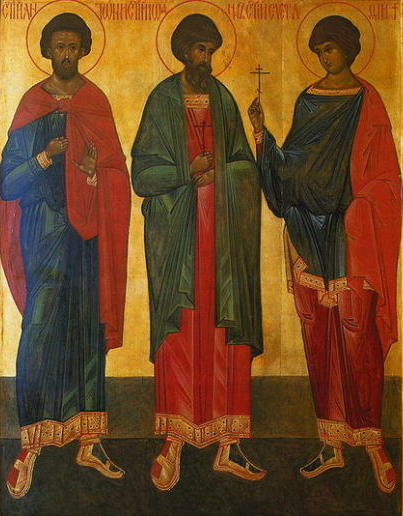
St. John, St. Anthony, St. Eustace (Lithuanian: Jonas, Antanas, Eustachijus)
Commemorated by the Catholic Church annually on April 27th.
St. John, St. Anthony, and St. Eustace are the most renowned Orthodox holy martyrs of Lithuania. In 1969 Pope Paul VI declared them saints of the Roman Catholic Church.
The account of the martyrdom of these saints indicates that brothers Kumetis and Nezilas were pagan nobles with their origins in Lithuanian lands. They served in the court of the Lithuanian Grand Duke Algirdas (father of Jogaila, the ruler of the Grand Duchy of Lithuania and Kingdom of Poland). Nestor, a priest who accompanied the wife of Grand Duke Algirdas to Vilnius, had a great impact on Kumetis and Nezilas, who later converted to Christianity. Their Christian names were Anthony and John. As was customary for Christians of that time, they began to fast when appropriate and stopped shaving their beards and cutting their hair. This offended other nobles of the court. Anthony and John were imprisoned and were being forced to abandon their faith. John renounced his faith after a year of imprisonment, but after witnessing the unwavering stance of his brother, converted back to Christianity. After being pressured by the nobles, Algirdas, the ruler of the Grand Duchy of Lithuania, sentenced the brothers to death by hanging in 1346.
Following the example of John and Anthony, their cousin Krulis also converted to Christianity and was given the baptismal name of Eustace. However in 1347, while being forced to renounce his faith, he was tortured to death most cruelly – his bones were shattered from being beaten, he was doused with cold water in the middle of winter, his hair was ripped out of his head, and finally, he was hanged. It is said, that at night the sons of Grand Duke Algirdas themselves took the martyr down and buried him next to his cousins – John and Anthony. After these events, devotion to the martyrs began, at first locally, then after a while, it spread internationally. In 1374 the remains of the martyrs were taken to Constantinople, where they were solemnly accepted by the Patriarch Philotheus.
Duke Algirdas, realizing that the new martyrs could be useful politically and help establish contact with the Byzantine Empire, ensured an Orthodox church was built on the site of the martyrdom. Originally, a wooden chapel was constructed. Later it was replaced by a masonry Orthodox church, and the remains of the martyrs were re-buried there. After the Union of Brest (1596), Greek Catholics of the Byzantine liturgical rite settled at this location. (Currently, the Holy Trinity Church occupies this site.) Russian Orthodox built a wooden church and the remains of the martyrs were transferred there. (Currently, it is the Russian Orthodox Holy Spirit Church). The Jesuits and the Greek Catholics of the Byzantine rite developed the iconography and the story of Saints John, Anthony, and Eustace, because they were one of the first and the first officially recognized Christian martyrs of Lithuanian lands.
St. John, St. Anthony, and St. Eustace were officially declared Eastern Orthodox saints in 1547, in Moscow. April 14th (according to the current calendar – April 27th) was designated as their feast day.
Seeking to protect the remains of the martyrs during World War I, they were taken to Moscow but ultimately returned to Vilnius after World War II, under the order of the Patriarch of Moscow. July 26th, the day the remains were returned to Vilnius, is one of the most important feasts for the local Eastern Orthodox faithful.
Aušros Vartų St. 10. Vilnius
Monday–Sunday – 10 a.m.–5 p.m.
Monday–Saturday – 8 a.m., 5 p.m.
Sunday – 7 a.m., 10 a.m., 5 p.m.
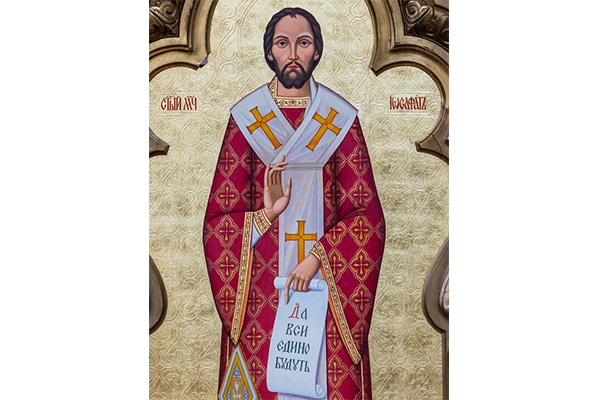
St. Josaphat Kuntsevych (Lithuanian: Juozapatas Kuncevicius), of the Order of Saint Basil the Great (1580-1623)
Commemorated by the Church on November 12th.
Josaphat Kuntsevych dedicated his entire monastic life to the unity of the Eastern and Western Christian Church. For that reason, he is considered a pioneer of ecumenism and a patron of those involved in ecumenical work. For his contributions toward the unification of the Christian Church, the remains of the Saint were buried in the altar of St. Basil the Great, in St. Peter’s Basilica in Rome.
He was born Ioann (Ivan) Kuntsevych in 1580 in the Volhynia region in what is now Ukraine, into a merchant’s family. He arrived in Vilnius in 1596 to learn the merchant’s trade in the academy founded by the Jesuits. In 1604 he entered the Basilian Monastery of the Holy Trinity in Vilnius and received the name of Josaphat.
He was tenacious as a pastor and had a great ability to connect with people. The Orthodox called him the “thief of souls” because he led a lot of Orthodox Christians to the Catholic Church. He reorganized the Basilian Order and founded the Order of St. Basil the Great – a Congregation of the Holy Trinity with its headquarters in Vilnius. He became the Archbishop of Polotsk in 1618. He strongly supported the union of the Catholic and Orthodox Churches, which was opposed by some Russian Orthodox. He was killed by the citizens of Vitebsk, who opposed the union of the Churches. Only 20 years after his death, Josaphat was beatified, and then proclaimed a saint by Pope Pius IX in 1867. The remains of Saint Josaphat were first kept at a Greek Catholic of the Byzantine rite Cathedral in Polotsk. Later, they were hidden at various locations in Lithuania, Poland, and Belarus; in 1916 the remains were transferred to St. Barbara’s Church in Vienna; and finally, in 1949, his remains were buried in St. Peter’s Basilica in Rome.
Aušros Vartų St. 7b, Vilnius
Monday–Saturday – 7.30 a.m.– 7 p.m.
Sunday – 8 a.m.–7 p.m.
Monday–Friday – 5.30 p.m.
Saturday – 10 a.m., 5.30 p.m.
Sunday – 10 a.m., 5.30 p.m.
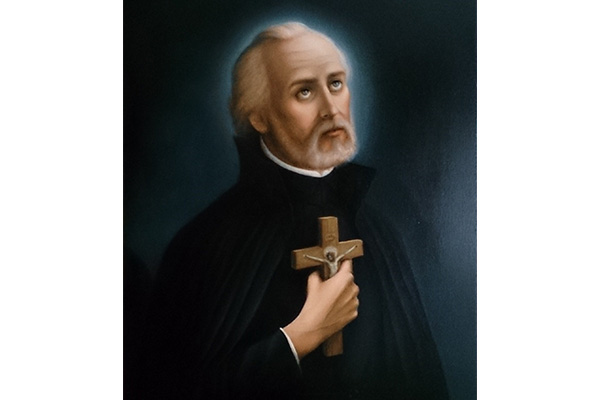
St. Andrew Bobola (Lithuanian: Andrius Bobola) , S.J. (1591-1657)
Commemorated by the Church on May 16th
The future Saint Andrew Bobola was born in 1591 in the town of Sandomierz, Poland. In 1611 he entered the Society of Jesus in Vilnius, studied philosophy and theology at Vilnius University, and worked at various locations in Lithuania’s Jesuit Province. St. Andrew Bobola spent a third of his life in Vilnius. For twelve years, he worked at St. Casimir Church: he was a preacher, a confessor, the rector of the Church, and a leader of the Sodality of Our Lady Society in Vilnius. In this Church, he has ordained a priest in 1622 and professed his solemn monastic vows in 1630. During the Polish-Lithuanian war with Moscow of 1655, raging Cossacks demonstrated a particular hatred for Catholicism in Lithuania. Renowned for his missionary work, Father Bobola was captured by Cossacks in 1657 and brutally tortured to death on May 16th, after refusing to renounce the Catholic faith.
Almost fifty years later in 1702, during the Great Northern War, Martin Godebski, the rector of Pinsk College, saw an unfamiliar Jesuit, who was radiating ethereal light, and who promised that he, Andrew Bobola, would protect the College against the enemy army if the rector found his body. After three days of searching the coffin was found, even though neither the rector nor anyone else, knew who Andrew Bobola was or where his body had been buried. Despite constant moisture at his burial site, the martyr’s body had not decomposed, nor did it emit any odor. After that news spread, the residents of Pinsk and surrounding areas started gathering to pray by the crypt. When the City of Pinsk was skirted by the marauding army, and the entire region of Pinsk was untouched by the plague, Andrew Bobola’s veneration grew very rapidly.
Andrew Bobola was beatified in St. Peter’s Basilica in 1853 and was declared a saint in 1938. His remains were transported from Italy to the St. Andrew Bobola Shrine in Warsaw. In Vilnius’s St. Casimir Church an Andrew Bobola image is displayed near the altar, and his relics are kept in the crypt.
Monday–Friday – 11 a.m.–7 p.m.
Sunday – 8 a.m.–7 p.m.
Monday–Friday – 5.30 p.m.
Sunday – 10.30 a.m., 12 p.m. (noon)
Sunday – 9 a.m.

St. Raphael of Joseph Kalinowski (Lithuanian: Rapolas Kalinauskas), O.C.D., (1835-1907)
Commemorated by the Church on November 20th
St. Raphael of Saint Joseph Kalinowski is the only saint who was born and raised in the city of Vilnius. He is considered a patron of Siberian exiles, soldiers, officers, and a guardian of people who find themselves in a hopeless situation.
Joseph Kalinowski was born in 1835 into a family of nobles. His father, Andrew Kalinowski, was a native of Grodno and worked at the Institute for Nobles as a superintendent and a lecturer of mathematics. Joseph’s mother Josephine Polonska died soon after he was born, and Joseph was raised first by his aunt Victoria Polonska and later by his stepmother Sophie Puttkamer – an educated, sensitive, and deeply religious woman, who imparted Christian moral principles to her children. Joseph Kalinowski received his general education at the Institute for Nobles. He was known as a gifted, diligent, and dutiful student. Later, he attended the School of Agriculture at Hory-Horki (now Belarus) and then at the Nicholayev Academy of Military Engineering in Saint Petersburg, where Tsarist army officers were trained. During the Crimean War, he was appointed as an army engineer, and after graduation, he worked as a lecturer of mathematics. Living in Saint Petersburg, Joseph longed for Vilnius and also suffered a crisis of faith.
Though Joseph Kalinowski would have preferred to distance himself from the revolutionary propaganda and terror, in 1863, he became actively involved in the Lithuanian and Polish uprising even though, having had experience in war, he recognized that it was doomed to fail. He emphasized that the country needed to work rather than shed blood and that an unarmed peoples’ struggle against a strong Russian army had no chance of success. Nonetheless, he was responsible for organizing the insurrectionist groups and for supplying food and weapons. Joseph was arrested even though there was no evidence of his participation in the uprising. He decided to take responsibility because he wanted his case closed and any new arrests prevented. Typically rebels were condemned to death, but Joseph Kalinowski’s sentence was commuted to 10 years of hard labor in Siberia, without the right to return to Vilnius.
While in Vilnius during the uprising, Joseph Kalinowski went to confession at the Missionary Church, at which time he returned to the faith and visited the Gate of Dawn daily. During his interrogation, he was imprisoned in the Dominican monastery (which had been converted into a prison) near the Holy Spirit Church. He spent his days living by the monastery rule: he rose at dawn and prayed, meditated, read books, contemplated, and through the window listened to the sounds of the Holy Mass. At the labor camp, he worked processing salt. It was here Joseph Kalinowski decided to dedicate all his spare time preparing for monastic life.
After serving his sentence in Siberia, he worked in Paris as a tutor for the son of Duke Czartoryski. Soon both a student and a teacher became monks. August Czartoryski joined the Salesians, and Joseph Kalinowski entered the Discalced Carmelite monastery in Graz (Austria) in 1877. During his robing ceremony, he received the monastic name of brother Raphael of St. Joseph. After taking his solemn perpetual vows and after being ordained a priest, he became the prior of the monastery at Czerna near Krakow. He successfully reformed and revitalized the monastery. After more than 10 years, he was appointed a prior of Wadowice monastery, where he led the construction of the monastery and St. Joseph’s Church. Later, he became the provincial’s vicar for the affairs of the Discalced Carmelite nuns and diligently cared for their religious life. Additionally, he founded many Catholic organizations throughout Poland and Ukraine and established several new Carmelite convents in Przemysl and Lviv. He spent much of his time listening to confessions, and was referred to as the “Martyr of the Sacrament of Reconciliation”. In Ukraine, he cared not only for Catholics, but lovingly served the local Orthodox faithful, and sought the unification of the Eastern Orthodox Church with Rome. He wrote a four-volume historical account of the Discalced Carmelite nuns in Poland, Lithuania, and Russia and several pastoral publications, which he authored or translated from French. Father Raphael Kalinowski died on November 15, 1907, a traditional day of Carmelite prayer for all deceased monks. He was buried in the monastery cemetery in Czerna, and soon after his tomb was renowned for miracles.
His beatification process began on May 5, 1934. His remains were transferred to the monastery chapel in Czerna. Father Raphael Kalinowski was beatified by Pope John Paul II in 1983. In 1991 Blessed Raphael of Joseph Kalinowski was declared a saint.
Monday–Saturday – 3 p.m., 6 p.m.
Sunday – 8 a.m., 9 a.m. (for children), 10.30 a.m.,
12 p.m. (for youth), 1.30 p.m., 6 p.m.
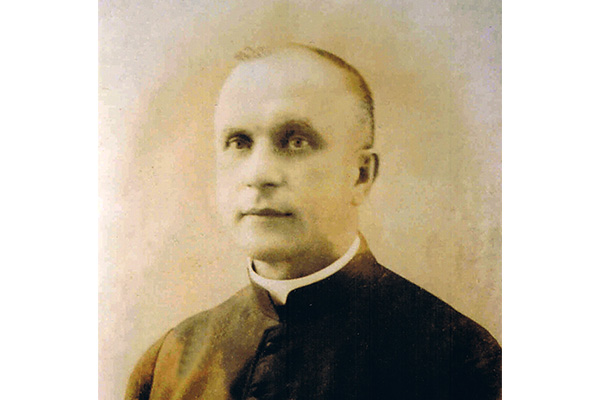
Blessed Michael Sopocko (Lithuanian: Mykolas Sopocka) (1888-1975)
Commemorated by the Church on February 15th
Blessed Michael Sopocko is known as the Apostle of Mercy. In Vilnius, he met St. Faustina and became her spiritual guide and confessor. Since then, he dedicated his entire life to the propagation of the message of Divine Mercy, and Vilnius became the city from which this message spread to the world. Encouraged by him, Sister Faustina began recording her mystical experiences in a diary, which has become a well-known book throughout the world. On the initiative of the Blessed Michael Sopocko, the image of Divine Mercy, which was based on the visions of Jesus experienced by St. Faustina, was painted. Additionally, he established a new religious congregation, currently known as the Congregation of Sisters of Divine Mercy, and initiated the celebration of Divine Mercy Sunday.
Michael Sopocko was born in 1888 in Juszewszczyzna in the county of Asmena (present-day Belarus). He graduated from Vilnius Seminary and in 1914 was ordained as a priest. From 1914 to 1918, he worked as a vicar in Tabariskes parish (district of Vilnius) and was largely responsible for the revival of pastoral care in his parish. Later he studied theology and pedagogy at the University of Warsaw, and also became a military chaplain. In 1924, after receiving an invitation from Blessed Jurgis Matulaitis, the Archbishop of Vilnius, he returned to the city, where he continued working as an army chaplain and organized Catholic youth associations within the archdiocese.
From 1927 to 1932, he was the spiritual director at the seminary in Vilnius, and from 1928 was a professor at the Department of Theology at Stefan Batory (Lithuanian: Steponas Batoras) University, which currently is Vilnius University. Between 1934 and 1938, he was the rector of St. Michael’s Church and also served as a chaplain for the Bernardine Sisters.
With the start of the Second World War, he further expanded his pastoral activities, especially by teaching and distributing prayers and images of Jesus of Divine Mercy. At that time, the Congregation of Sisters of Divine Mercy began to develop. In the apparitions to St. Faustina, Jesus had asked that such a congregation, praying for God’s mercy for the world, be established.
According to Father Michael Sopocko, he was fortunate to escape arrest by the Nazis and did so only due to the intercession of Divine Providence. For two and a half years (1942-1944), he remained in hiding in Juodsiliai, near Vilnius. After the Nazis retreated, he again settled in Vilnius and resumed teaching at Vilnius Seminary.
Father Sopocko died in 1975 in Bialystok. Before his death, anticipating that he would not be returning to Vilnius, he told the Sisters that they should return to the city. The Sisters of Divine Mercy finally arrived in Vilnius in 2001. Coincidentally, their monastery was established in the building which previously had belonged to the convent of the Visitation Order, where for a few years Blessed Michael Sopocko had lived, and where the image of Divine Mercy was painted.
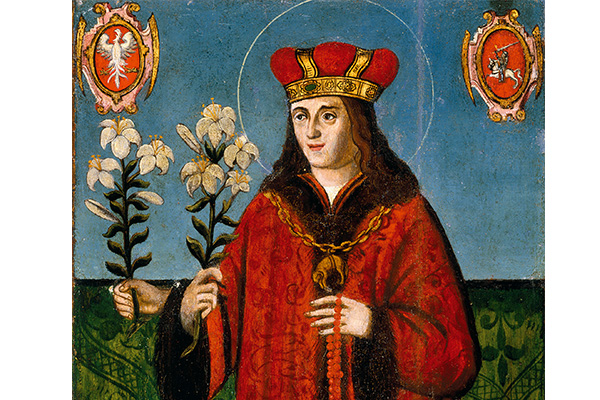
St. Casimir (Lithuanian: Kazimieras) (1458-1484)
Commemorated by the Church on March 4th
St. Casimir was the son of Casimir IV, the Grand Duke of Lithuania and the King of Poland. St. Casimir was declared a patron of Lithuania and Poland, and also of Lithuania’s youth. The city of Naples and the Knights of Malta, who had fought against Muslim Turks in the Mediterranean area, also consider St. Casimir as their patron. In Venezuela, there is a small town named in the Saint’s honor, as well as St. Casimir Church and Monastery. This Saint sets an example for young people because of his prudence, justice, sensitivity, and chastity.
Prince Casimir was born in Wavel Castle in Krakow on October 3, 1458. As a child, he was educated by the best teachers of the time. One of them – Jan Dlugosz – was a famous historian and a priest of Krakow. According to surviving historical accounts, the Prince was an extremely gifted student. He was very eloquent and fluent in Latin, Polish, and German languages. According to historians, St. Casimir is described as a person of refined taste, an educated mind, great eloquence, and nobility.
One of the most memorable events of Prince Casimir’s life was when at the age of thirteen he marched with the army to claim the throne of Hungary. When the military expedition failed, the young Prince had to bear the shame and humiliation resulting from his military defeat and unsuccessful political strategy. It is believed that this event had a strong influence on the formation of St. Casimir’s character. Throughout the remainder of his life, he never participated in any other military engagements. It wasn’t until several decades after his death that he repeatedly inspired Lithuanian army victories. In one of those instances he appeared on horseback in front of the Lithuanian army, and on another occasion, he answered the prayers of Lithuanian troops by helping them defeat the much larger army of Moscow.
Growing up surrounded by royal luxury, Casimir remained strong and steadfast in his chosen ascetic way of life. The Prince was his father’s constant travel companion and assisted in all his work. Together with his father he participated in parliamentary sessions, consulted with representatives of the nobility, and greeted guests. It was expected that he would succeed his father to the throne. For several years while King Casimir IV spent most of his time in Lithuania, Prince Casimir served as the acting regent of Poland. He distinguished himself as a wise and just ruler, reduced the State’s treasury debt, and improved relations between Poland and Rome.
After several years Casimir developed tuberculosis. During the remaining years of his life, the Prince aided his father in ruling Lithuania. In Vilnius, just like earlier in Krakow and Radom, he cared for the poor, was generous to the churches and monasteries, and sponsored the Bernardines, who was established by his father. While living in Vilnius, Casimir devoted a large portion of his time to prayer. He would even get up at night to pray at churches. Since at that time they would be closed, the Prince would often be found kneeling at the locked door. St. Casimir was called the embodiment of silent piety. Another important facet of the Saint’s life was a deliberate choice to remain chaste. At that time, it was believed that spending a night with a woman was a cure for tuberculosis. It is said that his parents and relatives tried their best to convince the Prince to do it, but he reproached them saying that they should be ashamed of offering this impermissible solution.
St. Casimir died in Grodno on March 4, 1484. His parents brought his remains to Vilnius and laid them to rest in a chapel, which they had built for their family in Vilnius Cathedral. In 1636 his remains were solemnly transferred to a specially-built St. Casimir Chapel.
The Prince’s reputation of his sanctity reached Rome only several years after his death. He was canonized in 1521.
Monday– Sunday – 7 a.m.–7 p.m.
Excursions are not available during the Holy Mass.
Monday–Saturday – 8 a.m., 5.30 p.m.
Sunday – 8 a.m., 9 a.m., 10 a.m., 11.15 a.m., 12.30 p.m., 5.30 p.m.
Sunday – 6.30 p.m.
Church Heritage Museum
Tel.: +370 600 12080
Email: katedrospozemiai@bpmuziejus.lt
www.bpmuziejus.lt

Blessed Jurgis Matulaitis (1871-1927)
Commemorated by the Church on January 27th
Bishop Jurgis Matulaitis was a person who had a significant impact during his lifetime. He renewed the Marian Order, cared for youth, established several religious orders, and sought to involve the early 20th century Catholic Church to teach and work in the field of social justice. Conservative Catholics called him a dangerous modernist, because of his active involvement in applying social teaching in the Church. He carried out all of his tasks with the utmost humility, professionalism, and by his resolve to “overcome evil with good”. Suffering from bone tuberculosis did not seem to impede this dynamic person, moreover, it demonstrated that all is possible for those who trust God and seek to renew His kingdom on Earth. People who knew him admired his profound and serene tranquility. In his beatification decree, a lot of attention was given to discussing Matulaitis’s extraordinary wisdom. Even in the most complicated circumstances, he made decisions and acted as one would expect from an honorable person, Christian, bishop, and monk.
Jurgis Matulaitis was born in 1871 in Lugine village near Marijampole. By the time he was ten, he had lost both of his parents and was being raised by his brothers. During his childhood, he developed bone tuberculosis and suffered from it for the rest of his life.
In 1891 he entered Kielce Seminary in Poland. In 1893 he continued his studies at the Warsaw Seminary. He received his Master’s Degree from the Theological Academy of Saint Petersburg, Russia, and was awarded a gold medal. He was ordained a priest in Saint Petersburg in 1898. A year later he furthered his studies at the University of Fribourg (Switzerland), where he defended his dissertation for which he received the highest honors and where he attained his Doctorate in Sacred Theology. Matulaitis was involved with Christian social work, organized workers, established orphanages, and helped the poor, despite the ethnic and religious differences of that period. From 1907 to 1911 he taught sociology at the Theological Academy of Saint Petersburg.
In 1909 Matulaitis secretly entered the Marian Order, which the Tsarist authorities were in the process of eradicating at that time, and updated its regulations. After the death of the last Marian General Reverend Vincentas Senkus, Matulaitis was elected Superior General of the Marian Order in 1911. In Fribourg, he secretly founded a Marian novitiate and headed the monastery from 1911 to 1914.
In Warsaw, Matulaitis founded a Marian institution to educate boys and reestablished the Marian monastery in Bielany. In 1918 he revived the Marian center in Marijampole and established the Congregation of Sisters of the Immaculate Conception of the Blessed Virgin Mary.
In 1918 he has consecrated as a bishop of Vilnius and appointed to administer the Vilnius Diocese. Because of local ethnic and political disputes, the following years were marked by extreme suffering for Matulaitis. In 1924 Matulaitis established the Handmaids of Jesus in the Eucharist Congregation.
In 1925, Matulaitis resigned as Bishop of Vilnius, however soon after, he was appointed an Archbishop and Lithuania’s Apostolic Visitator by Pope Pius XI. He was largely responsible for the improvement of relations between Lithuania and the Holy See, the establishment of the Ecclesiastical Province of Lithuania, and the development of a concordat.
He died in Kaunas in 1927. His last testamentary words were: “Organize and dedicate yourselves!” Pope Pius XI has repeatedly called Jurgis Matulaitis “a man of God, truly a holy man.”
In 1934 Archbishop Matulaitis’s remains were solemnly relocated from a crypt in Kaunas Cathedral to St. Archangel Michael Church in Marijampole, where they were placed into a specially prepared tomb in the Sacred Heart Chapel. In 1987 Pope John Paul II beatified Jurgis Matulaitis. It was a very significant event in Lithuania, which was still occupied at that time. The beatification coincided with the 600 year Jubilee celebration of the Christianization of Lithuania. Today, the relic of Blessed Jurgis Matulaitis is in the chapel of St. Peter in Vilnius Cathedral Basilica.
Monday– Sunday – 7 a.m.–7 p.m.
Excursions are not available during the Holy Mass
Monday–Saturday – 8 a.m., 5.30 p.m.
Sunday – 8 a.m., 9 a.m., 10 a.m., 11.15 a.m., 12.30 p.m., 5.30 p.m.
Sunday – 6.30 p.m.
Church Heritage Museum
Tel. +370 600 12080
Email: katedrospozemiai@bpmuziejus.lt
www.bpmuziejus.lt

St. Maria Faustina Kowalska (1905-1938)
Commemorated by the Church on October 5th
St. Faustina is one of the most renowned mystics of the Catholic Church. She is referred to as the “Apostle of Divine Mercy”, who was entrusted by Jesus to spread the message of Divine Mercy to the entire world.
St. Faustina was born in Poland in 1905 and was baptized with the name Helena. Because of the difficult financial situation of her family, Faustina only briefly attended school and then started working very young, mostly as a servant. From early childhood, she stood out because of her love of prayer and profound spiritual experiences.
She entered the Congregation of the Sisters of Our Lady of Mercy in 1925 and took the religious name of Sister Maria Faustina. Having difficulty interpreting the mystical experiences she was having, Faustina sought guidance from her confessors and superiors and even asked that God, Himself, or through the intercession of someone else, to help her understand those experiences. Faustina first arrived at the convent in Vilnius in 1929 and later lived there from 1933 to 1936. In this city, she met Blessed Michael Sopocko, who became her spiritual father, confessor, and executor of the requests she had received in her visions. During Faustina’s time in Vilnius, the Divine Mercy Chaplet was dictated, and the image of Divine Mercy was painted according to her directions. Because of the meeting of these two saints, Vilnius became the City from which the message of Divine Mercy spread to the world.
St. Faustina passed away from tuberculosis on October 5, 1938. She was only 33 years old. She was laid to rest in the convent’s cemetery, located in Krakow’s Lagiewniki district. With the start of her beatification process, her remains were relocated to the chapel. Faustina was beatified in 1993 and was declared a saint of the Church in 2000.
Monday–Sunday – 10 a.m.–5 p.m.
Chaplet of Divine Mercy is prayed daily at 3 p.m.
Vilniaus piligrimų centras
Company code: 305627846
AB SEB bankas
SWIFT (BIC): CBVILT2X
LT777044090101076736
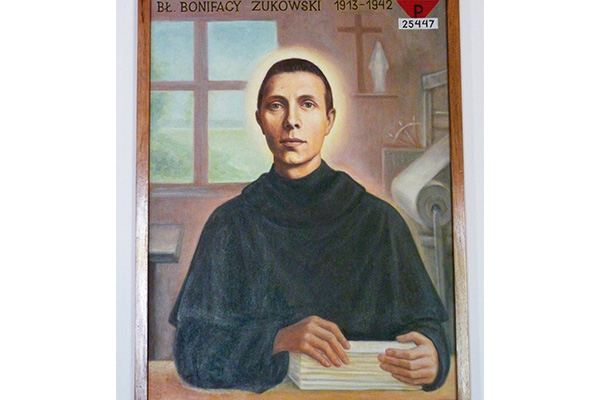
Blessed Piotr Boniface Zukowski (Lithuanian: Piotras Bonifacas Zukovski), O.F.M. (1913-1942)
Commemorated by the Church on April 10th and on June 12th as one of the 108 Martyrs of World War II
Piotr Zukowski was born in 1913 in the village of Reva, Nemencine parish, near Vilnius. After completing Elementary School he helped with the farm and worked the land. At the age of seventeen, he entered the Order of Friars Minor Conventual (Conventual Franciscans) in Niepokalanow, Poland, taking the name Boniface.
Brother Boniface had an important position in a Niepokalanow printing house, which printed Catholic publications. He also belonged to the Franciscan fire brigade.
When the Second World War began, he remained in the monastery and risked his life to protect printing equipment. In 1941 he was arrested by the Gestapo along with five other brothers and imprisoned in Pawiak penitentiary in Warsaw. Even under those conditions, the monks did not lose hope: they prayed, sang hymns, provided spiritual strength to other prisoners, and shared with them their food rations.
In 1942 Brother Boniface became a prisoner in Auschwitz, receiving prisoner number 25447. He was designated a member of the clergy, which exposed him to, especially cruel treatment. He worked the most difficult jobs, such as transporting building materials, gravel mining, and as a roofer. He was beaten and humiliated but endured all the sufferings patiently in the spirit of faith. He died in a prison hospital on April 10, 1942, due to complications from pneumonia. His body was incinerated in the camp crematorium.
He was beatified on June 13, in 1999, in Warsaw, during John Paul II’s seventh apostolic trip to Poland, during which 108 martyrs of World War II, including Piotr Boniface Zukowski, were beatified. He is one of the seven Franciscans who were beatified by the Pope and who, the Holy Father said, “went straight to heaven from hell on earth, which was Auschwitz concentration camp”.
Many sites memorializing the 108 martyrs, including Blessed Piotr Boniface Zukowski, can be found in Poland. In his birthplace in Reva village, Lithuania, a cross was erected in 2012 to mark the 70th anniversary of the death of Blessed Piotr Boniface Zukowski, who was martyred for his faith and his homeland.
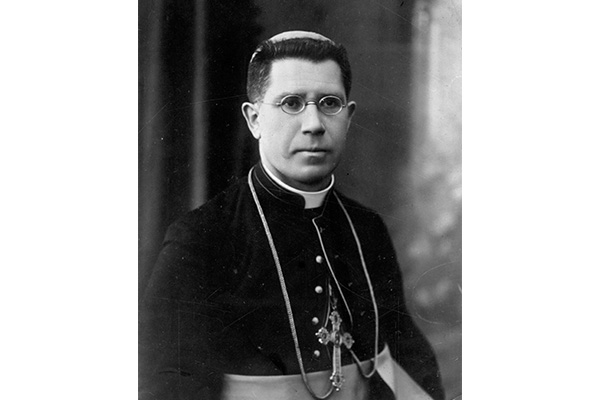
Servant of God Archbishop Mecislovas Reinys (1884-1953)
To Archbishop Mecislovas Reinys, prayer had great significance from childhood to the end of his life. During incarceration periods it was the source of strength and peace, not only for the bishop, but for other detainees who observed him praying often. People recalled that Mecislovas Reinys always carried a small cross with him, which he was able to safeguard during both incarceration periods, and which he would clasp in his hand before interrogations.
Bishop M. Reinys lived during the restoration of Lithuania’s Independence and was an active religious and public figure. He completed many important tasks in restoring the Lithuanian state. He served as the Minister of Foreign Affairs and made significant contributions to strengthening relations between Lithuania and the Holy See. He especially cared for the youth, enhancing their pastoral care, assisting with their education, encouraging the creation of Lithuanian youth organizations and then monitoring them, and participating in their events.
Archbishop M. Reinys was born to a family of farmers in 1884, in Madagaskaras, in the district of Utena. The family was able to send him to school, because he was bright and also the youngest child. In 1900 he graduated high school in Riga with a gold medal. In 1905 he entered Vilnius Seminary and later studied at the Theological Academy of Saint Petersburg. He was ordained a priest in 1907. From 1909 to 1912 he studied philosophy, theology, science and psychology, and received his Doctor of Philosophy degree from Leuven University. From 1913 to 1914 he studied apologetics in the Department of Theology at the University of Strasbourg.
He taught philosophy at Vilnius Seminary, and when Vytautas Magnus University was established, became a professor of psychology there. While in Vilnius, Father Reinys actively participated in the Lithuanian national revival movement. As a result, in 1919 he was arrested by The Red Army and imprisoned for nearly half a year.
Father Reinys was consecrated a bishop in 1926, and served as an assistant bishop in Vilkaviskis until 1940, when he was appointed an assistant to the Archbishop of Vilnius. After Vilnius Archbishop Romuald Jalbrzykowski was ordered to move to Poland, Bishop Reinys administered the Diocese of Vilnius between 1945 and 1947. Rising tensions between residents of different nationalities in the Vilnius Region, along with the onset of the Second World War, required a lot of strength and dedication from the Bishop to continue his pastoral work. It should be noted, that during his years in Vilnius, Bishop Reinys spread the message of Divine Mercy, even before such devotion had been officially approved by the Holy See. The Bishop approved the Lithuanian translation of the Divine Mercy Chaplet and gave permission to Fr. Michael Sopocko to celebrate the Divine Mercy Sunday at Sts. Johns’ Church.
On June 12th, 1947, Bishop Mecislovas Reinys was arrested by Soviet authorities. Having experienced the most difficult living conditions, hard labor and torturous interrogations, he died in Vladimir prison in 1953. Surviving recollections from other political prisoners – diplomats and priests – attest to the fact that Archbishop M. Reinys was a very strong and tranquil person, who prayed continually and cared for other prisoners. The Bishop was buried in a mass grave together with other prisoners. Containers of earth brought back from Vladimir prison cemetery, are stored at Vilnius Cathedral Chapel of Exiles and at the churchyard in his native parish of Daugailiai.
Currently, documents are being prepared to begin the beatification case of the Archbishop.
Aukų St. 2A, Vilnius
Wednesday–Saturday – 10 a.m.–6 p.m.
Sunday – 10 a.m.– 5 p.m.
Monday– Sunday – 7 a.m.–7 p.m.
Excursions are not available during the Holy Mass
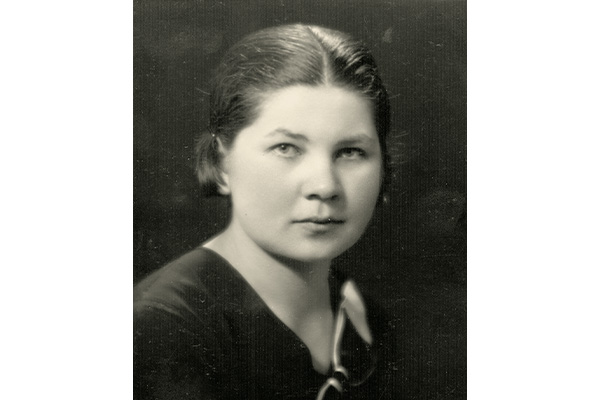
Servant of God Adelė Dirsytė (1909-1955)
Adelė Dirsytė was a Catholic, a teacher, a member of the Catholic Federation “Ateitis”, who was accused of anti-Soviet activities and exiled to Siberia. During her imprisonment she strived to uphold the spirits of the other inmates. For this she was cruelly tortured and starved, and eventually died in Siberia. On various materials found in prison, she wrote a prayer book entitled, “Mary, Save Us”, which eventually reached the free world and later printed and translated into twelve languages.
Adelė Dirsytė was born in a county near Kėdainiai, in a rural district of Šėta. She went to school at Šėta pro-gymnasium and attended Kėdainiai High School. In 1928 she entered the Department of Theology and Philosophy at Lithuania University in Kaunas; studied Germanic and Lithuanian philology, also pedagogy and psychology.
She gave lectures at meetings of Catholic organizations, was the board secretary of the Lithuanian Catholic Women’s Association (LCWA) and director of “Caritas”, took care and provided relief to orphans and the poor, wrote religious poetry, was an active public figure, organized courses and read lectures for women. A large part of her lectures were dedicated to the theme of being a woman and a mother. The article “Mother, Communism and the Fight Against it” (“Moteris” Magazine, 1938, No. 1) was found during a search, and became an important piece of evidence against her.
In 1940, she moved to Vilnius and was a German teacher in girls’ high school until 1942, then in Vilnius State Craft School No. 2 in 1942–1944 and starting from 1944, in Duchess’ Birutė Gymnasium (later, S. Nėris’ Gymnasium). She especially cared for the morality and education of the girls. Adelė was also actively engaged in charitable activities of Catholic Youth Federation “Ateitis”.
In 1946 she was arrested and brutally interrogated in the basement of the KGB jail in Vilnius. A military tribunal sentenced her to 10 years in a concentration camp in Russia. She was forced to do the most difficult work: in construction, building railroads and working in the forest at a logging station. After particularly brutal torture, she was transferred to a psychiatric hospital. She died or was killed in Khabarovsk in 1955, on her way back to Lithuania. Her prayer book, originally written on tree bark and scraps of paper, was released in the United States in 1959. In Lithuania, it was first released secretly in the underground in 1964.
The beatification process of Servant of God Adelė Dirsytė began in 2000 with a Holy Mass in Kaunas Cathedral Basilica.
Aukų St. 2A, Vilnius
Wednesday–Saturday – 10 a.m.–6 p.m.
Sunday – 10 a.m.– 5 p.m.

Servant of God Father Alfonsas Lipniūnas (1905–1945)
A courageous homilist who witnessed the truth of Christ in his life, a friend of the youth, an educator, the chaplain of prisoners at the Stutthof Concentration Camp, and comfort to the disheartened.
Alfonsas Lipniūnas was born in the village of Talkoniai, in Pumpėnai county, Panevėžys district, in a family of nine children. After graduating from primary school, Alfonsas wanted to continue his education in high school. He didn’t want to ask for parental support, and so he began to tutor a group of students privately. This activity allowed not only Alfonsas but also his other brothers to begin their studies at the Panevėžys Boys High School. He was still contemplating his calling, and wrote in his diary: “It is better to be a good priest than a bad official.”
When Father Lipniūnas graduated from Kaunas Seminary, Bishop Kazimieras Paltarokas appointed him Vicar of Panevėžys Cathedral, and as a youth leader of the diocese. He managed to bring together youth to form social welfare and charitable groups. The young volunteers visited people living in shelters and orphanages, sick people, and often brought food to those in need. Fr. Lipniūnas also focused on Ateitininkai (the Catholic Youth Organization), and Pavasarininkai (a Catholic Youth organization). Later, upon the encouragement of the bishop, he went to study sociology in France.
After returning to Lithuania, in 1939 he was appointed lecturer at Panevėžys Pedagogical Institute. After the Institute was relocated, he came to live and work in Vilnius. In addition to other duties, he began to teach Pastoral Theology and Sociology at the Vilnius Seminary. He also became the Chaplain of Vilnius University and delivered homilies at the Church of St. Johns. Although he did not regard himself as a good orator, a mixed crowd of believers and non-believers, Lithuanians and Poles, men and women, would gather to hear his homilies at the Chapel of the Gate of Dawn, and the Church of St. Johns. He was very observant and attentive to the needs of the people, so in 1941, he established a Freedom Fund which assisted war victims by providing welfare, and organized distribution of food rations. In Vilnius, he was the guardian of the Catholic Youth Federation “Ateitis” and was their spiritual leader and coordinator of their activities.
Because of his open opposition to the Nazi government in his homilies, and his influence on young people urging them not to join the Nazi Army units, Fr. Lipniūnas, together with 46 Lithuanian intelligentsia – professors, writers, and priests – were taken to Stutthof Concentration Camp.
In March of 1945, as the front line was approaching, Fr. Lipniūnas failed to return to his homeland. He was plagued by various illnesses, was completely exhausted, and died in Puck, Poland near Gdansk. In September 1989, his remains were finally transferred to the churchyard of Panevėžys Cathedral. Memories of Fr. Lipniūnas and the stories about his holiness began to spread after the burial of his remains. In 2006, the case for beatification was opened in the Diocese of Panevėžys (postulator Fr. Vitalijus Kodis). In 2021, the beatification case of Fr. Lipniūnas was transferred to the Congregation of the Holy See.
September–May
Tuesday–Thursday – 6 p.m. (in a chapel)
Friday – 6 p.m. (for students)
Sunday – 11 a.m., 1 p.m.
June–August
Sunday – 11 a.m
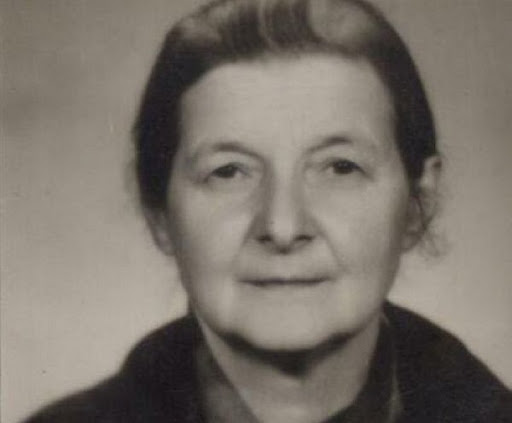
Sister Helena Majewska CSA (1902-1967)
St. Faustina Kowalska’s mission was continued by Sister Helena Majewska, teacher, and preceptor of the first Sisters of Merciful Jesus, a mystic, and visionary. The Blessed M. Sopoćko was her spiritual advisor.
Helena Majewska was born in 1902 in Podole (current Ukraine). In 1924, she moved to Vilnius with her parents. In Vilnius, she became acquainted with the Congregation of the Sisters of Angels, and joined the order in 1933, encouraged by their example. Since childhood, Helena experienced mystical visions in which Jesus Christ manifested himself. Her visions were becoming more frequent, and she appealed to Rev. Michael Sopoćko in April 1940 to help her understand her mystical experiences. At that time, the priest had already become engaged in the mission of Divine Mercy, had written articles, was working on the verification of Divine Mercy Sunday, and was preparing candidates for the Sisters of Merciful Jesus.
In 1941, the first candidate to the order that Jesus envisioned, Jadvyga Osinska, was sent to Pričiūnai (Vilnius district), so that Sr. Helena Majewska could foster her and assist in her development. That is how Sr. Helena became the educator and spiritual leader of the first Sisters of the Merciful Jesus. Candidates for the order often went on retreats with Sr. Helena, and she took care of their spiritual preparation.
Fr. Sopoćko encouraged Sr. Helena, much like St. Faustina, to begin writing a diary describing her mystical visions, and conversations with God. She did not reveal her diary to the other sisters and did not talk about it. The diaries were found in the archives of the congregation after the death of Sr. Helena.
In 2020, the diary of Sr. Helena Majewska, translated into Lithuanian, was published by Catholic World Publications.
After WWII, although repatriation of residents of Vilnius to Poland was taking place, Sr. Helena, along with other nuns of the Sisters of Angels, remained in Vilnius. She worked as a secretary of the Polish school in Antakalnis. In 1950, Soviet officials arrested Sr. Helena for anti-Soviet activities, and charges were based on the distribution of illegal Catholic publications, and illegal convent life. She was sentenced to five years exile in Karaganda, Kazakhstan by a court decision. After the exile, she returned to Vilnius and died here in December 1967. She was buried at Saltoniškės Cemetery.

Servant of God Wanda Boniszewska CS (1907-2003)
Mystic, marked by stigmas – the wounds of Jesus’ body that opened up during the crucifixion, sacrificed her suffering for the conversion of priests and nuns.
Wanda was the fourth child in the family of Helena and Francis Boniszewska, who lived in the territory of current Belarus, near Novogrudok. All eleven children of this family received a religious education. One of the memories from Wanda’s childhood was written about in her diary. She remembered the moment when she was at church with her parents, and how she kept thinking about the Blessed Sacrament being enclosed in the tabernacle. “Poor Jesus is closed up in there. He must be lonely.” Her devotion to Christ, protected in the Eucharist, and frequent adoration, became important and frequent events in the spiritual life of Wanda.
In 1925, she joined the Congregation of the Sisters of Angels in Vilnius. Sister Vanda gave her permanent vows at Vilnius Calvary in 1933. Soon after that, she experienced one of the spiritual visions during which she realized that her monastic life will be marked by moments of suffering and that she must sacrifice for the indifferent and sinful priests and the nuns in her order. Wanda called Jesus a prisoner of love. It was from Him that she heard in one mystical vision about how often He was rejected and was not understood by those closest to Him – priests and nuns. Thus, Sister Wanda committed to pray for priests and nuns, offer their intention with her suffering, and fast.
Sr. Wanda experienced not only spiritual visions, but also moments of ecstasy, and then the stigmata began. At first, after joining the convent, she only felt the inner pain in those places on the body where Christ had wounds. The external stigmata became visible in 1934.
After taking her permanent vows, Wanda moved to the convent house in Pričiūnai, near Vilnius. Despite having the opportunity to go to Poland after the war, she remained in Lithuania. She helped priests, concealed monks and clergy, and secretly catechized children. For this activity, Sr. Wanda spent 1951‒1956 exiled in Siberia, where she strengthened the faith and hope of the prisoners. She returned to Poland after repatriation and died in 2003 in Konstantine-Jeziorna.
St. George’s Parish in Buivydžiai organizes a traditional pilgrimage every summer – In the Footsteps of the Sisters of Angels: Wanda Boniszewska and Helena Majewska from the village of Buivydžiai to the Chapel of Pričiūnai. In November 2020, the Archdiocese of Warsaw began the beatification process for Sr. Wanda Boniszewska.




